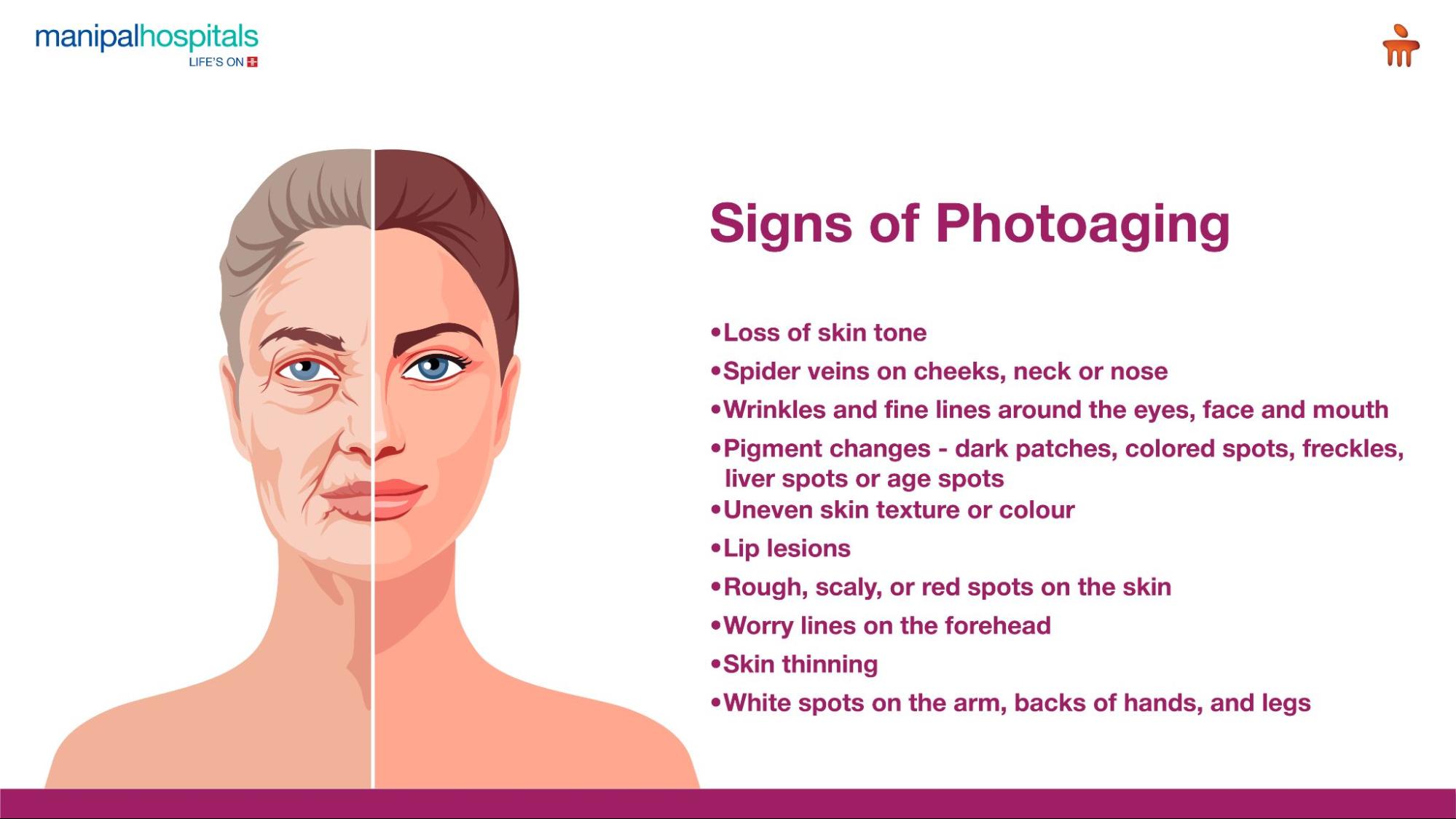Did you know that sunlight, while essential for the body’s functioning and providing warmth during winters, can also cause sun-damaged skin, leading to premature ageing? Regardless of the season, harmful UV rays can penetrate the skin and damage its deeper layers. This process, known as photoageing or sun-induced skin ageing, is a growing concern, especially in India, which has a significant elderly population.
Although exact data on the prevalence of photoageing in India are limited, studies have found that chronological ageing (natural ageing over time) is more common in females and those with Type IV skin. In contrast, photoageing, characterised by wrinkles, skin discolouration, rough skin texture, pigmentation, etc., tends to be more frequent in males and individuals with lighter skin tones.
In this blog, we will explore the signs, causes, and treatment options for sun-damaged skin.
Synopsis
Understanding Photoageing
When the skin undergoes premature ageing due to prolonged and repeated exposure to ultraviolet radiation (UVA and UVB) of the sun, it is known as photoageing. The damage can also be caused by artificial UV light sources such as tanning beds or sun lamps. This process ages your skin more quickly, boosting the natural ageing process, called chronological ageing.
Photoageing also increases the risk of skin cancer. Photoageing is also known as photodamage, sun damage, solar damage, dermatoheliosis, and extrinsic ageing.
Signs of Photoageing

Unlike chronological ageing, the signs of photoageing usually begin in the teenage years to early 20s, often showing signs of visible sun damage on the face. These include:
-
Loss of skin tone in sun-exposed areas, i.e., the loss of elasticity
-
Spider veins on cheeks, neck, or nose, also known as telangiectasia
-
Wrinkles and fine lines around the eyes, face, and mouth
-
Pigment changes, such as dark patches, colored spots, freckles, liver spots, or age spots
-
Uneven skin texture or colour
-
Lip lesions, known as actinic cheilitis
-
Rough, scaly, or red spots on the skin, known as actinic keratosis
-
Worry lines that appear on the forehead
-
Skin thinning
-
White spots on the arm, backs of hands, and legs, known as idiopathic guttate hypomelanosis
If you experience any of these signs of sun-damaged skin, get an evaluation done by a dermatologist for early diagnosis and treatment.
Causes of Photoageing
The ultraviolet radiation of the sun causes DNA changes in the skin cells, causing photoageing and skin cancer. Two types of ultraviolet light make the changes. These are:
-
UVA light: This type of UV light can penetrate all levels of the skin, from epidermis to dermis. Epidermis, the outermost layer, is responsible for smoothness and youthful appearance, whereas the dermis, the deepest layer, has collagen and elastin to provide skin tightness and elasticity. The UVA light mainly causes long-term skin damage, affecting collagen, elastin fibres, epidermal cells, and tiny blood vessels. It can also lead to skin cancer.
-
UVB light: This type of UV light can penetrate the epidermis layer, damaging the DNA of epidermal cells more potently than UVA light, causing photoageing and the formation of precancerous cells, called actinic keratosis. These rays cause sunburn and are the cause of most skin cancers.
Treatment of Photoageing
Although photodamage can’t be completely reversed, the best treatment for sun-damaged skin on the face, as recommended by dermatologists, can help rejuvenate the skin. These include:
-
Topical medications: Certain products, like retinoids and retinols such as tretinoin, help treat fine lines, wrinkles, and age spots; reduce roughness and the signs of pores by stimulating collagen and sloughing off old cells so that new cells can come up.
-
Laser Skin Resurfacing: This technique treats uneven skin pigmentation, fine lines, wrinkles, etc., by removing the damaged top layer of skin and increasing the collagen production. Fractional resurfacing uses microbeams of laser light to rejuvenate the lower layers of skin through tissue coagulation. Other lasers, such as pulsed dye lasers, remove redness and broken blood vessels, while picosecond and nanosecond lasers address pigmentation concerns.
-
Chemical peels: Using trichloroacetic acid and glycolic acid as chemical peels helps remove the outermost skin layer, making space for the new layer. These peels remove brown spots and actinic keratosis and improve the skin's lines, tone, and texture.
-
Photodynamic Therapy: A medication is applied to the skin, and a blue or red fluorescent light is used to activate the medication, which destroys the precancerous cells while leaving the normal cells.
-
Cryotherapy: This therapy involves using liquid nitrogen to freeze noncancerous age spots or actinic keratosis. After a few days, the treated area becomes dark and sheds off.
In addition to these treatments, dermal fillers, dermabrasion, using lightening agents, vitamin C and other antioxidants, alpha-hydroxy acid, facelifts, neck lifts, or other plastic surgery procedures can be used to treat or reduce the signs of photoageing.
Conclusion
Sun-damaged skin may not always be fully reversible, but with timely care, its effects can be significantly reduced. Home remedies for treating sun-damaged skin, like aloe vera gel, green tea compresses, honey masks, and regular moisturising, can help soothe and repair the skin over time. For best results, combine these remedies with proper sun protection, sunscreen, a healthy diet, and regular skincare practices. Early prevention and consistent care remain key to maintaining youthful, radiant skin; thus, seek a consultation with a dermatologist at Manipal Hospitals, Dhakuria.
FAQ's
Chronological ageing is the natural ageing process of the skin that occurs due to age and genetics, known as intrinsic ageing, and is not preventable. On the other hand, photoageing is caused by long-term exposure to UV radiation from the sun and can be prevented or reduced by taking precautions.
It cannot be completely prevented, as avoiding sunlight is nearly impossible and not wise. However, by taking the following steps, the risk of sun-damaged skin can be reduced:
-
Use broad-spectrum, water-resistant sunscreen of SPF 30 or higher every day.
-
Avoid going out in peak UV hours, i.e., from 10 am to 4 pm
-
Avoid tanning your skin
-
Wear a hat, sunglasses, and fully covered clothing while going out in the sun
Photoageing usually occurs at the most visible areas of the skin that are exposed to the sun, such as the face, neck, back of hands, arms, legs, and upper chest.
If photoageing is not treated or managed on time, it can lead to an increased risk of melanoma and precancers, such as actinic keratosis; the development of seborrhoeic keratosis, actinic lentigines, and telangiectasia; and the worsening of rosacea.
Although younger skin responds better to skin treatments, it is never too late to reverse the effects of photoageing. Seek a consultation with a dermatologist at Manipal Hospitals, Dhakuria, for a complete evaluation and effective treatment.






















 6 Min Read
6 Min Read













